
- Microsoft Azure Tutorial
- Microsoft Azure - Home
- Cloud Computing - Overview
- Microsoft Azure - Windows
- Microsoft Azure - Components
- Microsoft Azure - Compute Module
- Microsoft Azure - Fabric Controller
- Microsoft Azure - Storage
- Microsoft Azure - Blobs
- Microsoft Azure - Queues
- Microsoft Azure - Tables
- Microsoft Azure - CDN
- Microsoft Azure - Applications
- Microsoft Azure - Security
- Microsoft Azure - Datacenters
- Microsoft Azure - Scenarios
- Microsoft Azure Advanced
- Microsoft Azure - Management Portal
- Azure - Create Virtual Network
- Azure - Deploying Virtual Machines
- Azure - Endpoint Configuration
- Azure - Point-to-Site Connectivity
- Azure - Site-to-Site Connectivity
- Microsoft Azure - Traffic Manager
- Microsoft Azure - PowerShell
- Azure - Monitoring Virtual Machines
- Azure - Setting Up Alert Rules
- Azure - Application Deployment
- Microsoft Azure - Backup & Recovery
- Azure - Self-Service Capabilities
- Azure - Multi-Factor Authentication
- Azure - Forefront Identity Manager
- Azure - Data Import & Export Job
- Microsoft Azure - Websites
- Microsoft Azure - Scalability
- Microsoft Azure - Disk Configuration
- Microsoft Azure - Disk Caching
- Microsoft Azure - Personalize Access
- Azure - Personalize Company Brand
- Azure - Self-Service Password Reset
- Microsoft Azure - Self-Service Group
- Microsoft Azure - Create a Group
- Azure - Security Reports & Alerts
- Azure - Orchestrated Recovery
- Microsoft Azure - Health Monitoring
- Microsoft Azure - Upgrades
- Microsoft Azure Useful Resources
- Microsoft Azure - Quick Guide
- Microsoft Azure - Useful Resources
- Microsoft Azure - Discussion
Microsoft Azure - Websites
There is a detailed description of how to create websites in Azure in the chapter, ‘Compute Module’. Azure websites service is named ‘Web Apps’ everywhere in the management portal so don’t get confused. This chapter will discuss few more terms associated with Azure websites. In normal hosting environment, developers usually encounter problem when they deploy their websites in production. Azure websites service ensures that developers encounter least problems while deploying their websites. Also, Azure website service comes under PaaS (Platform as a Service). This means that websites can be deployed without actually having a full-fledged infrastructure.
Create a Website in Azure Management Portal
Just to reconnect with the website creation, let’s take a look at these steps of how to create a website in Azure Management portal.
Step 1 − Login to your management portal.
Step 2 − Click ‘New’ at the left bottom corner of the screen → Compute → Web Apps → Quick Create.
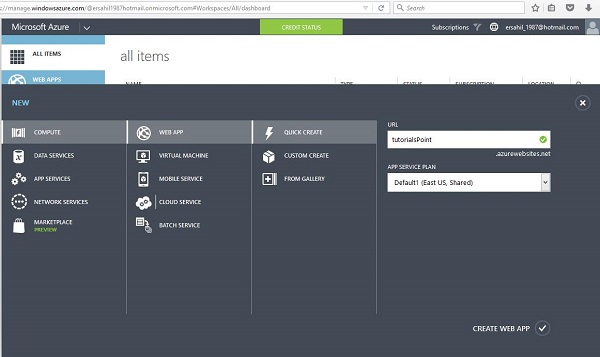
Step 3 − Enter the details as shown in the picture above and click ‘Create Web App’.
Step 4 − Go back to websites in your management portal and you will see it listed. Click the URL.

You will be taken to the website that you just created.
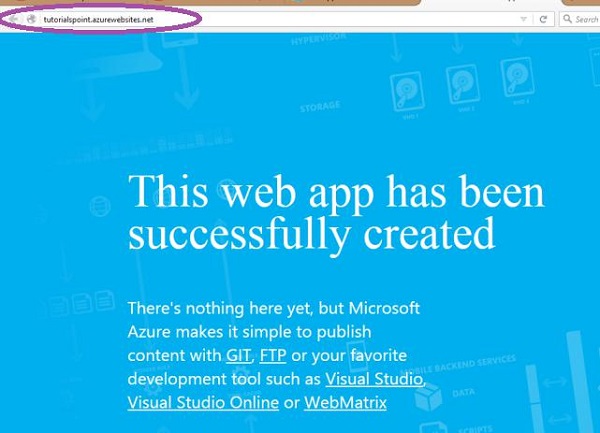
Deploying Azure Website from Visual Studio
Let’s publish our website from Visual Studio in the domain name we just created. After a website or web application is created in Visual Studio.
Step 1 − Go to Solution Explorer and right click on the website/webapp name.
Step 2 − Choose ‘publish’.
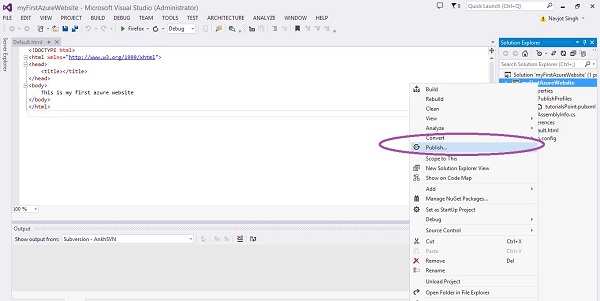
Step 3 − In this step, you need to connect to Azure subscription account in order. Click ‘Import’.
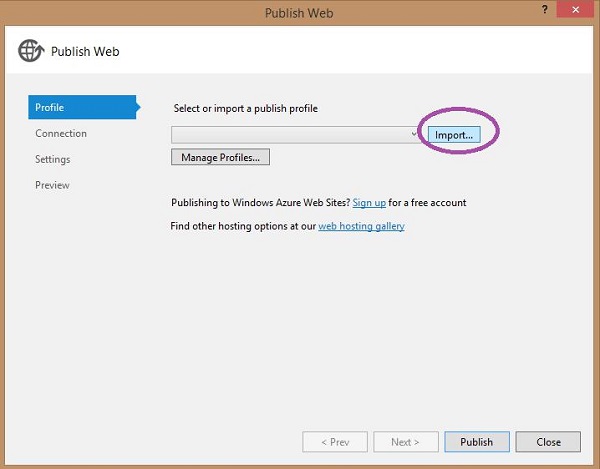
Step 4 − Click ‘Add Azure Subscription’.
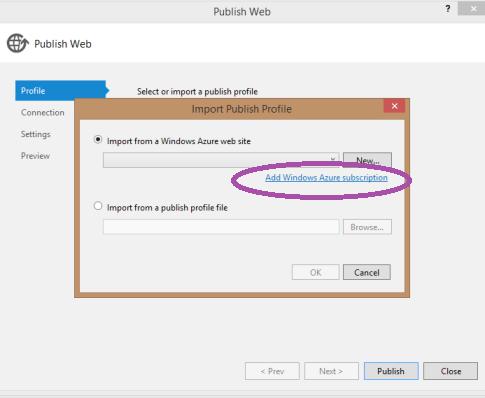
Step 5 − For the first time, you will have to ‘Download Subscription file’.
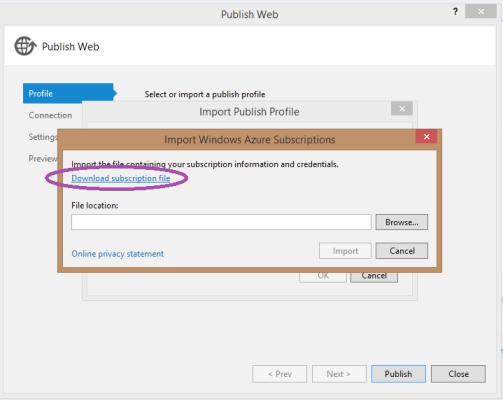
Step 6 − The above step will download a file with extension .publishsetting on your computer (if you are not logged in, it will ask you to login before downloading).
Step 7 − Come back to the same pop-up and now browse for the file that was just downloaded.
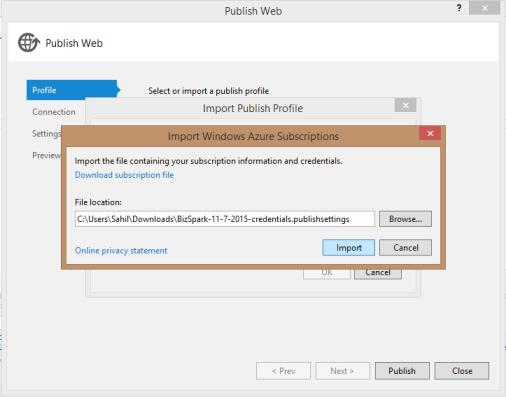
Step 8 − Now expand the dropdown and you will see the websites available in your subscription. As in the picture below you can see two websites. Let’s select ‘tutorialsPoint’.
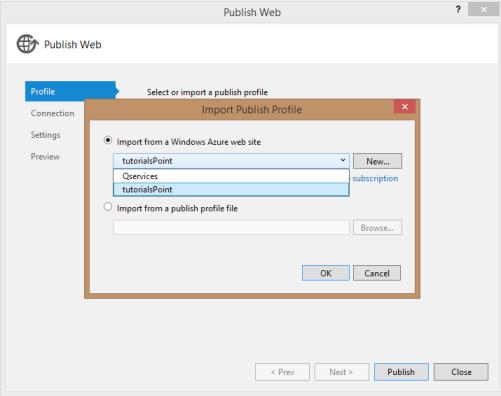
Step 9 − On the following screen, leave the defaults on. There are many options for public methods. We need ‘Web Deploy’ method here. Click ‘Validate Connection’.
Step 10 − On the next screen, again the leave the defaults on.
Step 11 − Finally on the last screen, click publish.
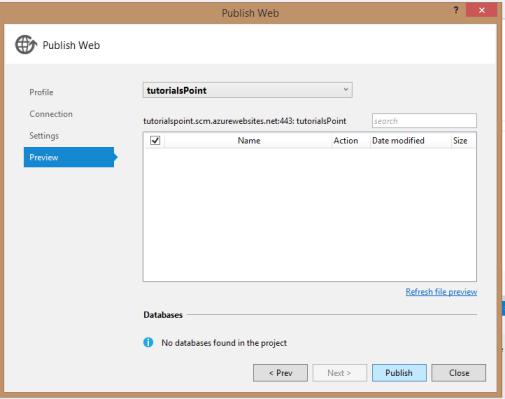
Step 12 − Go to the URL of website and you will see your content.
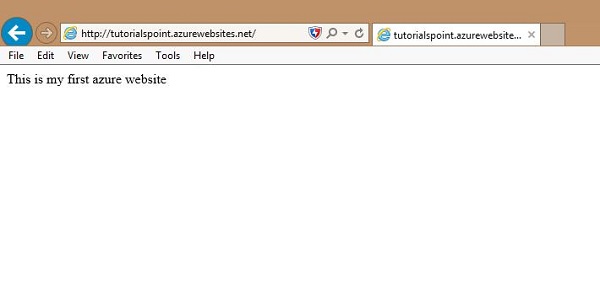
You can see how easy it is to deploy a website in Azure using Visual Studio. You can make changes in Visual Studio and publish it from there itself. This makes testing of applications very easy.
Monitoring the Website
In the management portal, if you go to the website’s dashboard you can see the figures related to the website. You can control lots of things related to your website from this section of your management portal. You can see the website metrics, create backup, configure setting, and scale the website.
Step 1 − To see the website metric, select monitor from top menu and you will see the following screen.
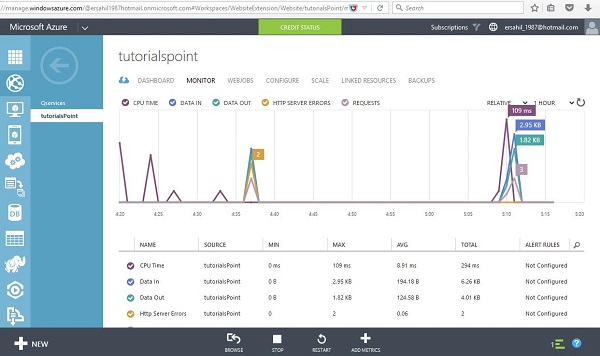
Step 2 − Go to the website and select ‘Dashboard’ from the top menu.
Step 3 − Scroll down and you will see the following information.
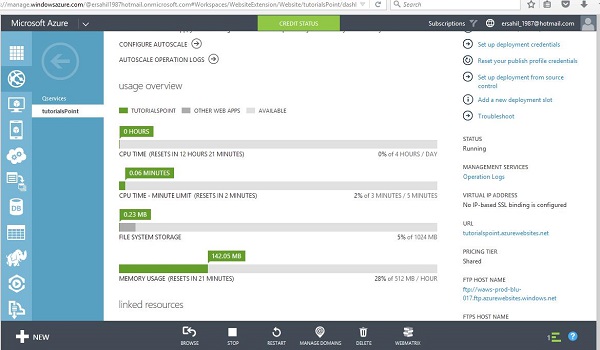
Staged Publishing
Windows Azure enables the deployment of a website in stages. You can create the deployment slots.
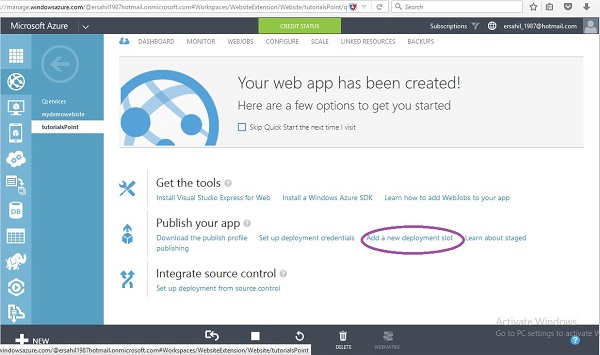
Add a Deployment Slot for Testing Before Production
Basically, this feature allows you to deploy your website in a separate slot for testing purpose and then switch the slot. If anything goes wrong, you can simply go back to the previous version by changing the slot. Sometimes, applications don’t behave well as they are expected to at a large scale, this feature comes handy in such situations. This makes deployment tasks very easy for developers and organizations.